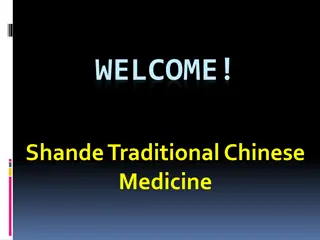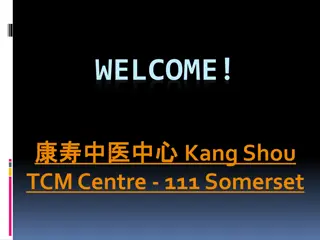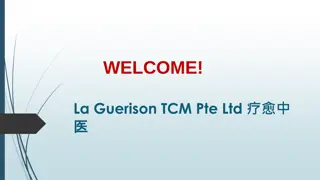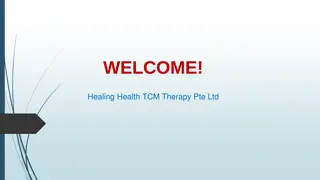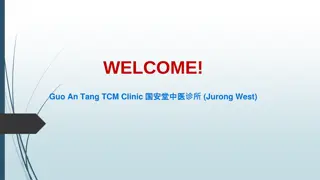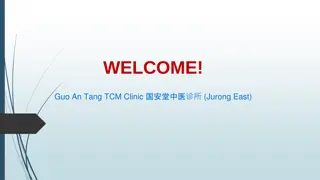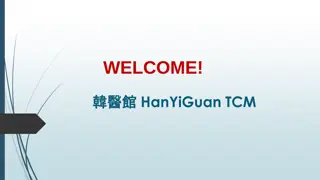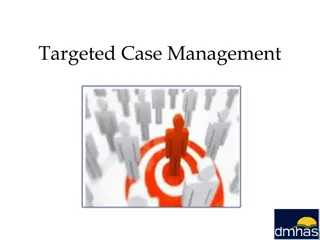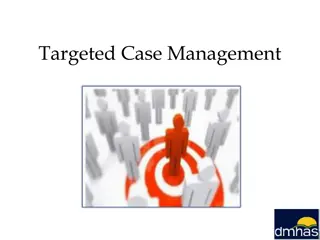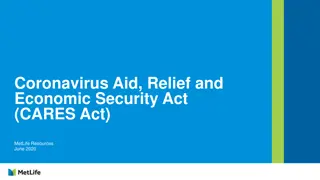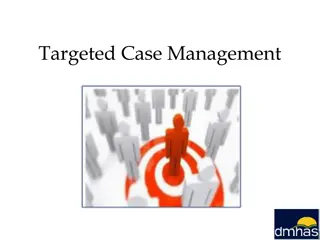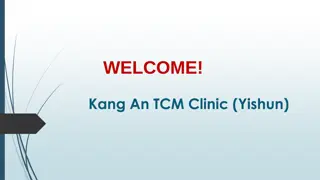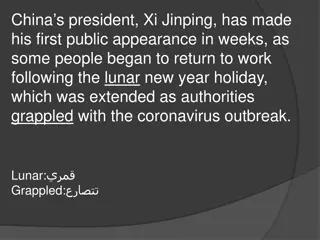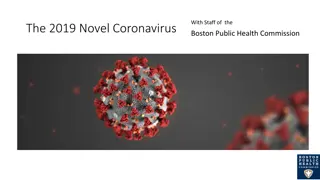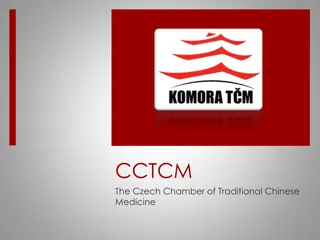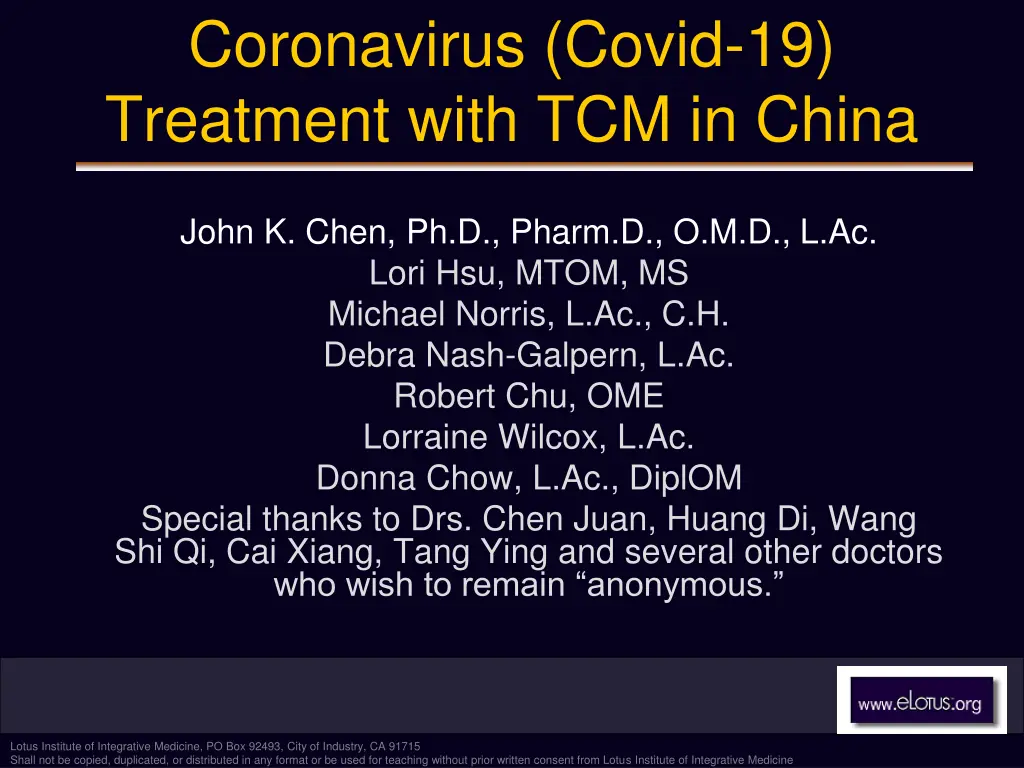
Coronavirus (Covid-19) Treatment Strategies in Traditional Chinese Medicine
Explore the use of Traditional Chinese Medicine (TCM) in treating Covid-19, including clinical manifestations, pathophysiology, and insights into cytokine storms. Understand the holistic approach in managing symptoms and supporting recovery. Discover valuable resources and expert insights on TCM for combating the coronavirus.
Download Presentation

Please find below an Image/Link to download the presentation.
The content on the website is provided AS IS for your information and personal use only. It may not be sold, licensed, or shared on other websites without obtaining consent from the author. If you encounter any issues during the download, it is possible that the publisher has removed the file from their server.
You are allowed to download the files provided on this website for personal or commercial use, subject to the condition that they are used lawfully. All files are the property of their respective owners.
The content on the website is provided AS IS for your information and personal use only. It may not be sold, licensed, or shared on other websites without obtaining consent from the author.
E N D
Presentation Transcript
Coronavirus (Covid-19) Treatment with TCM in China John K. Chen, Ph.D., Pharm.D., O.M.D., L.Ac. Lori Hsu, MTOM, MS Michael Norris, L.Ac., C.H. Debra Nash-Galpern, L.Ac. Robert Chu, OME Lorraine Wilcox, L.Ac. Donna Chow, L.Ac., DiplOM Special thanks to Drs. Chen Juan, Huang Di, Wang Shi Qi, Cai Xiang, Tang Ying and several other doctors who wish to remain anonymous. Lotus Institute of Integrative Medicine, PO Box 92493, City of Industry, CA 91715 Shall not be copied, duplicated, or distributed in any format or be used for teaching without prior written consent from Lotus Institute of Integrative Medicine
Biology Coronavirus is an RNA virus SARS-CoV causes SARS. SARS-CoV-2 causes Covid-19. 96% genome identity Report of the WHO-China Joint Mission on Coronavirus Disease (COVID-19) 16-24 February 2020. https://emcrit.org/ibcc/covid19/?fbclid=IwAR31Xy- vkhL39xSWNAqkx3fECRR2yQLVbyWD2EOOoDG7FYv2WXqdQm7Lu_U#biology
Clinical Manifestation Incubation: 2-14 days Resp s/sx: fever, dry cough, sneezing, runny nose, sputum production, nasal congestion, shortness of breath, lethargy, muscle pain, headache and dehydration. GI s/sx: 5-10% of patients can present initially with diarrhea or nausea, before fever and dyspnea Wang, et al. Clinical Characteristics of 138 Hospitalized Patients With 2019 Novel Coronavirus Infected Pneumonia in Wuhan, China. JAMA. Published online February 7, 2020. doi:10.1001/jama.2020.1585
Pathophysiology Cytokine storm: The coronavirus causes uncontrolled / dysfunctional immune response, leading to an overproduction of immune cells and their signaling molecules, resulting in a cytokine storm with a flood of immune cells into the lung. S/Sx include: severe inflammatory disease, shortness of breath, inflammation of the airway, and finally acute respiratory distress syndrome and multiple organ failure. https://www.the-scientist.com/news-opinion/why-some-covid-19-cases-are-worse-than-others-67160
Pathophysiology In addition to hyper-inflammatory injury, the lung suffers physical injuries (diffuse alveolar damage, including hyaline membranes) and physiological compromises (wheezing, shortness of breath, etc). Xu Z, et al. Pathological findings of COVID-19 associated with acute respiratory distress syndrome. https://www.thelancet.com/action/showPdf?pii=S2213-2600%2820%2930076-X
Biopsy Edema, proteinaceous exudate, focal reactive hyperplasia of pneumocytes with patchy inflammatory cellular infiltration, and multinucleated giant cells. Fibroblastic plugs were noted in airspaces. Xiao, Shu-Yuan. Pulmonary Pathology of Early COVID-19 Pneumonia Identified Retrospectively in Two Patients With Lung Cancer, The ASCO Post. 3/12/2020. https://ascopost.com/news/march-2020/pulmonary-pathology-of-early-covid-19-pneumonia-identified- retrospectively-in-two-patients-with-lung-cancer/
WM Diagnosis Signs and symptoms evaluation Nasopharyngeal swab Chest x-ray and CT scan
WM Diagnosis Lymphopenia is common, seen in ~80% of patients. Mild thrombocytopenia is common (but platelets are rarely <100). Lower platelet count is a poor prognostic sign. Guan W et al. Clinical Characteristics of Coronavirus Disease 2019 in China. The New England Journal of Medicine. February 28, 2020. Ruan Q et al. Clinical predictors of mortality due to COVID-19 based on an analysis of data of 150 patients from Wuhan, China. Intensive Care Med https://doi.org/10.1007/s00134-020-05991-x
WM Treatment Acetaminophen, aspirin, ibuprofen Antiviral: remdesivir, lopinavir, ritonavir. Chloroquine Steroids Immunosuppressant Ventilator ECMO
WM Treatment Convalescent plasma Convalescent sera Johns Hopkins University. https://hub.jhu.edu/2020/03/13/covid-19-antibody-sera-arturo-casadevall/
WM Treatment Vaccine for Covid-19 won t be deployed for at least 1 to 1.5 years. March 3, 2020 Anthony S. Fauci, M.D., Director of NAID (National Institute of Allergy and Infectious Diseases)
Prognosis Up to 70% of people get Covid-19. Most patients have mild illness. They don t require medical attention and aren't counted. The vast majority of infected patients (e.g. >80%) don't get significantly ill and don't require hospitalization. Individuals under 18 years of age make up only 2.4% of all reported cases. Individuals over 60 years of age, with pre-existing health conditions, have the highest risks. Report of the WHO-China Joint Mission on Coronavirus Disease (COVID-19) 16-24 February 2020. https://www.businessinsider.com/coronavirus-covid-19-angela-merkel-bundestag-infection-19-2020-3
Prognosis Among hospitalized patients: ~10-20% of patients are admitted to ICU. ~3-10% require intubation. ~2-5% die. Guan et al. Clinical Characteristics of Coronavirus Disease 2019 in China. The New England Journal of Medicine. https://www.nejm.org/doi/pdf/10.1056/NEJMoa2002032?articleTools=true
Prognosis Patients who survive the initial phases of the illness may still require prolonged ventilator support (due to pulmonary fibrosis). As the epidemic progresses, an issue which may arise is a large volume of patients unable to wean from mechanical ventilation. Zhang, W. Imaging changes of severe COVID-19 pneumonia in advanced stage. Intensive Care Med (2020). https://doi.org/10.1007/s00134- 020-05990-y
TCM and Epidemic Diseases There have been over 320 large-scale epidemics in China between Eastern Han and Qing Dynasty (approximately 2,000 years).
Zhng Zhng-Jng, 150-219 CE Shang Han (Cold-Induced Disorders) Taiyang Yangming Shaoyang Taiyin Shaoyin Jueyin
Y Gu, 1666-1745 Wen Bing (Warm Disease): wei (defensive) level qi (energy) level ying (nutritive) level xue (blood) level
TCM Pattern Differentiation Taiyang Yangming Shaoyang Taiyin Shaoyin Jueyin Wei (defensive) level Qi (energy) level Ying (nutritive) level Xue (blood) level
TCM Diagnosis Early S/Sx: Fever, dry cough, sneezing, runny nose, nasal congestion, shortness of breath, lethargy, muscle pain, headache and dehydration. Taiyang Wind-heat Wind-cold Wei (defensive) level
TCM Diagnosis Lymphopenia is common, seen in ~80% of patients. Mild thrombocytopenia is common. Qi deficiency Blood deficiency Guan W et al. Clinical Characteristics of Coronavirus Disease 2019 in China. The New England Journal of Medicine. February 28, 2020. Ruan Q et al. Clinical predictors of mortality due to COVID-19 based on an analysis of data of 150 patients from Wuhan, China. Intensive Care Med https://doi.org/10.1007/s00134-020-05991-x
TCM Diagnosis S/Sx: severe inflammatory disease, shortness of breath, inflammation of the airway Yangming Qi (energy) level
TCM Diagnosis Damp and phlegm in the Lung Lung heat, with Lung cold, with Edema, proteinaceous exudate, focal reactive hyperplasia of pneumocytes with patchy inflammatory cellular infiltration, and multinucleated giant cells. Fibroblastic plugs were noted in airspaces.
TCM Diagnosis S/Sx: cytokine storm leading to acute respiratory distress syndrome and multiple organ failure. Shaoyang Taiyin Shaoyin Jueyin Ying (nutritive) level Xue (blood) level
TCM Diagnosis In addition to hyper- inflammatory injury, the lung suffers physical injuries (diffuse alveolar damage, including hyaline membranes) and physiological compromises (wheezing, shortness of breath, etc). Lung yin deficiency Lung qi deficiency
TCM Diagnosis Patients who survive the initial phases of the illness may still require prolonged ventilator support (due to pulmonary fibrosis). Lung yin deficiency Lung qi deficiency
TCM and Covid-19 More than 85% of all patients with coronavirus, approximately 60,000 people, received herbal treatment along with western medicine treatments, as of late February 2020. Ministry of Science and Technology, China.
Hubei Provincial Hospital Wuhan Union Hospital Guidance for Covid-19 Prevention Phase Prevention Early Phase Wind-Heat Invading the Exterior Syndrome Medical Observation Period Pneumonia Phase Damp Warmth in Early Phase Damp Heat Obstructing the Lung Syndrome Epidemic Toxins Blocking the Lung Closed Interior and Abandoned Exterior Clinical Treatment Period Recovery Phase Insufficiency of qi and yin, Deficiency of Lung and Spleen. Recovery Period
Hubei Provincial Hospital of TCM Prevention Phase: Early Phase: Pneumonia Phase: Recovery Phase:
Prevention Phase: Early Phase: Wind-Cold Invading the Exterior Toxic Heat Attacking the Lung Damp Cold in the Lung Pneumonia Phase: Shaoyang Syndrome with Damp Damp Heat Afflicting the Lung Toxic Stagnation Obstructing the Lung Closed Interior and Abandoned Exterior Syndrome Recovery Phase:
Prevention Phase: Huang Qi (Radix Astragali) 15g Bai Zhu (Rhizoma Atractylodis Macrocephalae), dry fried 10g Fang Feng (Radix Saposhnikoviae) 10g Mian Ma Guan Zhong (Rhizoma Dryopteridis Crassirhizomatis) 10g Jin Yin Hua (Flos Lonicerae Japonicae) 10g Chen Pi (Pericarpium Citri Reticulatae) 6g Pei Lan (Herba Eupatorii) 10g
Prevention Phase: Bilateral Zusanli (ST 36), Qihai (CV 6), Zhongwan (CV 12) Moxa Zusanli (ST 36) on both sides for 15 minutes. Moxa Qihai (CV 6) or Zhongwan (CV 12) for 10 minutes. (alternating from treatment to treatment). Twice a day, once in the afternoon and once at night.
Early Phase: Wind-Cold Invading Exterior Toxic Heat Attacking the Lung Damp Cold in the Lung
Early Phase: - Wind-Cold Invading the Exterior S/Sx: Onset of fever (mostly low-grade fever), aversion to cold, chills, headache, ticklish throat, soreness of muscles of limbs, no sweat or night sweats. Exam: Lung CT negative. Tongue is pale, coating is white and thin. Floating pulse Treatment: Expel Wind, Release the Exterior; Clear Heat, Detoxify
Early Phase: - Wind-Cold Invading the Exterior GeGenTang (Kudzu Decoction) or Chai GeJieJiTang (Bupleurum and Kudzu Decoction to Release the Muscle Layer)
Early Phase: - Wind-Cold Invading the Exterior Ge Gen (Radix Puerariae Lobatae) 15g Ma Huang (Herba Ephedrae) 10g Gui Zhi (Ramulus Cinnamomi) 6g Bai Shao (Radix Paeoniae Alba) 15g Sheng Jiang (Rhizoma Zingiberis Recens) 10g Gan Cao (Radix et Rhizoma Glycyrrhizae) 10g Da Zao (Fructus Jujubae) 10g Jin Yin Hua (Flos Lonicerae Japonicae) 20g with headache, add Bai Zhi (Radix Angelicae Dahuricae) 15g with dry or ticklish throat, add She Gan (Rhizoma Belamcandae) 15g
Early Phase: - Toxic Heat Attacking the Lung S/Sx: Fever, aversion to cold, sore and dry throat, dry cough, scanty sputum, sore and painful muscles in the limbs, weakness, headache Exam: CT scan reveals both lungs to have scattered ground-glass opacity (GGO). Tip and sides of the tongue are red; thin white or yellow tongue coating. Floating and rapid pulse. Treatment: Expel Wind, Release the Exterior; Clear Heat, Detoxify
Early Phase: - Toxic Heat Attacking the Lung YinQiaoSan (Honeysuckle and Forsythia Powder) and QingWenBaiDuSan (Clear Epidemics and Overcome Pathogenic Influences Powder), modified
Early Phase: - Toxic Heat Attacking the Lung Jin Yin Hua (Flos Lonicerae Japonicae) 10g Lian Qiao (Fructus Forsythiae) 10g Jing Jie (Herba Schizonepetae) 10g Niu Bang Zi (Fructus Arctii) 10g Bo He (Herba Menthae) 10g Gan Cao (Radix et Rhizoma Glycyrrhizae) 10g Dan Zhu Ye (Herba Lophatheri) 10g Lu Gen (Rhizoma Phragmitis) 15g Huang Lian (Rhizoma Coptidis) 6g
Early Phase: - Damp Cold in the Lung S/Sx : Aversion to cold, fever or absence of fever, dry cough, dry throat, fatigue, weakness, chest stuffiness, epigastric distention, nausea, diarrhea. Exam: Pale tongue, white greasy coating, slippery pulse. Treatment: Expel Wind, Release the Exterior; Dispel Damp Cold
Early Phase: - Damp Cold in the Lung CangZhu (Rhizoma Atractylodis) 15g ChenPi (Pericarpium Citri Reticulatae) 10g Hou Po (Cortex Magnoliae Officinalis) 10g HuoXiang (Herba Pogostemonis) 10g CaoGuo (Fructus Tsaoko) 6g MaHuang (Herba Ephedrae) 6g Qiang Huo (Rhizoma et Radix Notopterygii)10g ShengJiang (Rhizoma Zingiberis Recens) 10g BingLang (Semen Arecae) 10g
Early Phase: Bilateral Hegu (LI 4), Taichong (LR 3), Zusanli (ST 36), Shenque (CV 8) Moxa Hegu (LI 4) and Taichong (LR 3) bilaterally for 15 minutes. Moxa Zusanli (ST 36) bilaterally for 10 minutes. Moxa Shenque (CV 8) with a moxa box for 15 minutes. Twice a day, once in the morning and once in the afternoon.
Pneumonia Phase: Shaoyang Syndrome w/ Damp Damp Heat Afflicting the Lung Toxic Stagnation Obst the Lung Closed Interior / Abandoned Exterior Syndrome
Pneumonia Phase: - Shaoyang Syndrome with Damp S/Sx : Fever, which is more pronounced in the afternoon, alternating chills with fever, cough, absence of wheezing, bitter taste in the mouth, dry mouth, chest stuffiness, stifling sensation, chest and hypochondriac fullness and distention, irritability, nausea or vomiting, no appetite, weakness. Similar to the beginning stage of pneumonia. Exam: CT scan reveals both lungs to have multiple scattered or large pieces of ground-glass opacity (GGO). Slightly red tongue, thick and greasy, white or yellow coating, slippery, rapid pulse. Treatment: Harmonize Shaoyang Syndrome, Clear Damp-Heat
Pneumonia Phase: - Shaoyang Syndrome with Damp XiaoChaiHuTang (Minor Bupleurum Decoction) with SanRenTang (Three-Nut Decoction) or GanLuXiaoDuDan (Sweet Dew Special Pill to Eliminate Toxins)
Pneumonia Phase: - Shaoyang Syndrome with Damp Chai Hu (Radix Bupleuri) 24g Huang Qin (Radix Scutellariae) 9g Sheng Jiang (Rhizoma Zingiberis Recens) 10g Fa Ban Xia (Rhizoma Pinelliae) 12g Ku Xing Ren (Semen Armeniacae Amarum) 15g Bai Dou Kou (Fructus Amomi Rotundus) 10g Yi Yi Ren (Semen Coicis) 30g Dan Zhu Ye (Herba Lophatheri) 15g Hua Shi (Talcum) 15g Tu Fu Ling (Rhizoma Smilacis Glabrae) 30g Gan Cao (Radix et Rhizoma Glycyrrhizae) 10g
Pneumonia Phase: - Damp Heat Afflicting the Lung S/Sx: Low-grade fever or absence of fever, dry cough, scanty sputum, dry and sore throat, fatigue, weakness, poor appetite, chest stuffiness, epigastric distention, nausea or vomiting, loose stool. Exam: CT scan reveals both lungs to have multiple scattered or large pieces of ground-glass opacity (GGO). Pale or pink, puffy tongue with teeth marks. White or greasy white coating. Soft or slippery pulse. Treatment: Transform Dampness, Detoxify; Disperse the Lungs and Expel Pathogens
Pneumonia Phase: - Damp Heat Afflicting the Lung MaXingYiGanTang (Ephedra, Apricot Kernel, Coicis, and Licorice Decoction), XiaoXianXiongTang (Minor Sinking into the Chest Decoction) and Cao Guo Zhi Mu Tang (Tsaoko and Anemarrhena Decoction)
Pneumonia Phase: - Damp Heat Afflicting the Lung Ma Huang (Herba Ephedrae) 10g Ku Xing Ren (Semen Armeniacae Amarum) 10g Yi Yi Ren (Semen Coicis) 30g Huang Lian (Rhizoma Coptidis) 6g Fa Ban Xia (Rhizoma Pinelliae) 10g Gua Lou Pi (Pericarpium Trichosanthis) 10g Cao Guo (Fructus Tsaoko) 10g Zhi Mu (Rhizoma Anemarrhenae) 10g Yu Xing Cao (Herba Houttuyniae) 15g Gan Cao (Radix et Rhizoma Glycyrrhizae) 10g Bai Dou Kou (Fructus Amomi Rotundus) 9g


